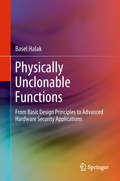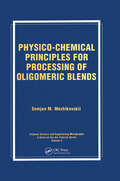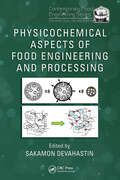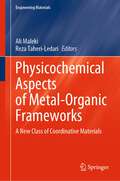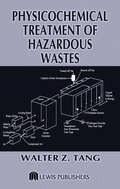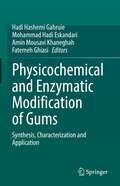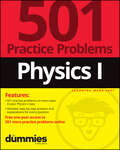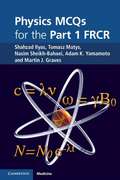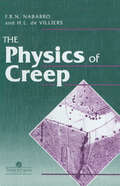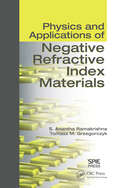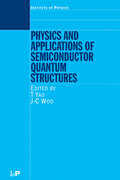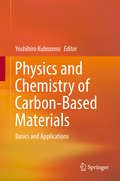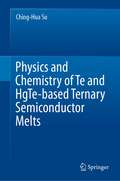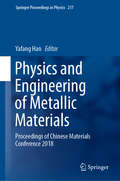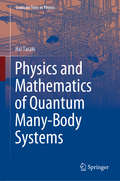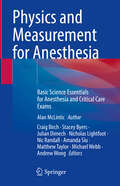- Table View
- List View
Physically Unclonable Functions: From Basic Design Principles To Advanced Hardware Security Applications
by Basel HalakThis book discusses the design principles of physically unclonable functions (PUFs) and how these can be employed in hardware-based security applications, in particular, the book provides readers with a comprehensive overview of security threats and existing countermeasures.This book has many features that make it a unique source for students, engineers and educators, including more than 80 problems and worked exercises, in addition to, approximately 200 references, which give extensive direction for further reading.
Physico-Chemical Principles for Processing of Oligomeric Blends (Polymer Science and Engineering Monographs)
by Semjon M MezhikouskiCovers the current state of theoretical and experimental studies of oligomeric mixed systems from the physico-chemical standpoint and provides a technologist with the means for the quantitative approach to preparing liquid oligomeric compositions and choosing proper operating conditions for their processing into materials and articles. Recommendations are given on the practical use of found physico-patterns as well as the physico-chemical analysis of the effect of the composition ingredients on the final properties.
Physico-Mathematical Theory of High Irreversible Strains in Metals
by V. M. GreshnovPresents a new physical and mathematical theory of irreversible deformations and ductile fracture of metals that acknowledges the continuous change in the structure of materials during deformation and the accumulation of deformation damage. Plastic deformation, viscous destruction, evolution of structure, creep processes, and long-term strength of metals and stress relaxation are described in the framework of a unified approach and model. The author then expands this into a mathematical model for determining the mechanical characteristics of quasi-samples of standard mechanical properties in deformed semi-finished products.
Physicochemical Aspects of Food Engineering and Processing (Contemporary Food Engineering Ser.)
by Sakamon DevahastinPhysical and chemical interactions between various constituents of foods resulting from processing operations often lead to physical, sensory, and nutritional changes in the properties of foods. Answering the need for a resource in this area, this volume describes the effects of various processing technologies in different food processing situations. A first part looks at the physicochemical property changes of different foods undergoing selected processes, such as drying, extrusion, microencapsulation, and microwave assisted thermal processing. The second part focuses on the changes of physicochemical properties of different products, such as seafood, meat, and confectionary products.
Physicochemical Aspects of Metal-Organic Frameworks: A New Class of Coordinative Materials (Engineering Materials)
by Ali Maleki Reza Taheri-LedariThis book presents a both detailed and comprehensive look at metal–organic frameworks (MOFs), a relatively new class of materials with a broad application potential. The beginning chapters focus on introducing the requisite fundamental knowledge of MOFs with respect to their classification, synthesis, functionalization approaches, and various other physiochemical facets such as structural morphology and coordination chemistry. The remaining chapters cover an array of diverse applications, from areas such as energy storage and environmental remediation, to drug delivery, biosensing, and tissue engineering.Featuring chapters dedicated to the design of novel MOF structures, as well as theoretical calculations via density functional theory and machine learning techniques, this book targets a wide readership of both academic and industrial researchers interested in an in-depth understanding of the latest MOF structure–function relationships, as well as their deployment in a wide variety of coordinated engineering applications.
Physicochemical Treatment of Hazardous Wastes
by Walter Z. TangThis book examines the treatability of hazardous wastes by different physicochemical treatment processes according to the Quantitative Structure and Activity Relationship (QSAR) between kinetic rate constants and molecular descriptors. The author explores how to use these models to select treatment processes according to the molecular structure of
Physicochemical and Enzymatic Modification of Gums: Synthesis, Characterization and Application
by Amin Mousavi Khaneghah Hadi Hashemi Gahruie Mohammad Hadi Eskandari Fatemeh GhiasiNatural gums are polysaccharides consisting of multiple sugar units linked together via glycosidic linkages. Most natural gums reveal appropriate safety for oral consumption in the form of food additives or drug carriers. Challenges related to the utilization of natural polysaccharides, however, include uncontrolled rates of hydration, pH dependent solubility, viscosity reduction during storage, and weak interfacial properties. Modification provides an efficient route for not only removing such drawbacks but also improving physicochemical properties, such as solubility, viscosity and swelling index, and introducing new properties for varied applications.This book provides a comprehensive review of the various modifications on gums to make them suitable for food, cosmetic and pharmaceutical industries. The book is divided in four parts: an introduction to natural gums followed by in-depth coverage of chemical modification, physical modification, and enzymatic modification of gums. Each chapter includes reaction mechanisms, physicochemical properties, rheological properties, interfacial properties, applications and future perspectives. Presenting a succinct account on gum modification from a practical point of view, this book is a helpful reference for academic and industrial scientists and engineers in food technology, materials chemistry, pharmaceuticals, chemical, industrial, and applied engineering, biochemistry, and biopolymers.
Physics Curiosities, Oddities, and Novelties
by John KimballAn Enlightening Way to Navigate through Mind-Boggling Physics ConceptsPhysics Curiosities, Oddities, and Novelties highlights unusual aspects of physics and gives a new twist to some fundamental concepts. The book covers both classical and modern physics in an engaging, straightforward style.The author presents perplexing questions that often lack
Physics Experiments with Arduino and Smartphones (Undergraduate Texts in Physics)
by Giovanni OrgantiniThis book on the use of Arduino and Smartphones in physics experiments, with a focus on mechanics, introduces various techniques by way of examples. The main aim is to teach students how to take meaningful measurements and how to interpret them. Each topic is introduced by an experiment. Those at the beginning of the book are rather simple to build and analyze. As the lessons proceed, the experiments become more refined and new techniques are introduced. Rather than providing recipes to be adopted while taking measurements, the need for new concepts is raised by observing the results of an experiment. A formal justification is given only after a concept has been introduced experimentally. The discussion extends beyond the taking of measurements to their meaning in terms of physics, the importance of what is learned from the laws that are derived, and their limits. Stress is placed on the importance of careful design of experiments as to reduce systematic errors and on good practices to avoid common mistakes. Data are always analyzed using computer software. C-like structures are introduced in teaching how to program Arduino, while data collection and analysis is done using Python. Several methods of graphical representation of data are used.
Physics I For Dummies
by Steven HolznerAn easy-to-follow guide to introductory physics, from the Big Bang to relativity All science, technology, engineering, and math majors in college and university require some familiarity with physics. Other career paths, like medicine, are also only open to students who understand this fundamental science. But don’t worry if you find physics to be intimidating or confusing. You just need the right guide! In Physics I For Dummies, you’ll find a roadmap to physics success that walks you through every major topic in introductory physics, including motion, energy, waves, thermodynamics, electromagnetism, relativity, and more. You’ll learn the basic principles and math formulas of physics through clear and straightforward examples and instruction, and without unnecessary jargon or complicated theory. In this book, you’ll also find: Up-to-date examples and explanations appearing alongside the latest discoveries and research in physics, discussed at a level appropriate for beginning students All the info found in an intro physics course, arranged in an intuitive sequence that will give first-year students a head start in their high school or college physics class The latest teaching techniques to ensure that you remember and retain what you read and practice in the bookPhysics I For Dummies is proof that physics can fun, accessible, challenging, and rewarding, all at the same time! Whether you’re a high school or undergraduate student looking for a leg-up on basic physics concepts or you’re just interested in how our universe works, this book will help you understand the thermodynamic, electromagnetic, relativistic, and everything in between.
Physics I: 501 Practice Problems For Dummies (+ Free Online Practice)
by The Experts at DummiesOvercome your study inertia and polish your knowledge of physics Physics I: 501 Practice Problems For Dummies gives you 501 opportunities to practice solving problems from all the major topics covered you Physics I class—in the book and online! Get extra help with tricky subjects, solidify what you’ve already learned, and get in-depth walk-throughs for every problem with this useful book. These practice problems and detailed answer explanations will help you succeed in this tough-but-required class, no matter what your skill level. Thanks to Dummies, you have a resource to help you put key concepts into practice. Work through practice problems on all Physics I topics covered in school classes Step through detailed solutions to build your understanding Access practice questions online to study anywhere, any time Improve your grade and up your study game with practice, practice, practiceThe material presented in Physics I: 501 Practice Problems For Dummies is an excellent resource for students, as well as parents and tutors looking to help supplement Physics I instruction. Physics I: 501 Practice Problems For Dummies (9781119883715) was previously published as Physics I Practice Problems For Dummies (9781118853153). While this version features a new Dummies cover and design, the content is the same as the prior release and should not be considered a new or updated product.
Physics MCQs for the Part 1 FRCR
by Tomasz Matys Nasim Sheikh-Bahaei Adam K. Yamamoto Shahzad Ilyas Martin John GravesPhysics MCQs for the Part 1 FRCR is a comprehensive and practical revision tool for the new format Part 1 FRCR examination, covering the complete physics curriculum. Key features: * Contains 300 questions that reflect the style and difficulty of the real exam * Covers basic physics, radiation legislation and all the imaging modalities included in the Royal College of Radiologists training curriculum and new FRCR examination * Includes new exam topics such as MRI and ultrasound imaging * Answers are accompanied by clear, detailed explanations giving candidates in-depth understanding of the topic * Much of the question material is based on the Radiology-Integrated Training Initiative (RITI), as recommended by the Royal College of Radiologists A must-have revision resource for all Part 1 FRCR candidates, Physics MCQs for the Part 1 FRCR is written by a team of specialist registrars who have recently successfully passed the Part 1 FRCR exam and a renowned medical physicist.
Physics Of Creep And Creep-Resistant Alloys
by F R Nabarro F. de VilliersUnique in its approach, this introduction to the physics of creep concentrates on the physical principles underlying observed phenomena. As such it provides a resource for graduate students in materials science, metallurgy, mechanical engineering, physics and chemistry as well as researchers in other fields. Following a brief mathematical treatment, the authors introduce creep phenomena together with some empirical laws and observations. The mechanisms of creep and diffusion under varying experimental conditions are subsequently analysed and developed. The second half of the text considers alloying in greater detail as well as exploring the structure and properties of superalloys and stress effects in these materials.
Physics and Applications of Negative Refractive Index Materials
by S. Anantha Ramakrishna Tomasz M. GrzegorczykEver since the first experimental demonstration was reported in 2000, the interest in metamaterials and left-handed media that exhibit a negative refractive index has increased exponentially. Surveying this explosive growth, Physics and Applications of Negative Refractive Index Materials covers the fundamental physical principles and emerging engin
Physics and Applications of Semiconductor Quantum Structures
by Takafumi Yao Jong-Chun WooWritten by international experts, Physics and Applications of Semiconductor Quantum Structures covers the most important recent advances in the field. Beginning with a review of the evolution of semiconductor superlattices and quantum nanostructures, the book explores fabrication and characterization techniques, transport, optical, and spin-depende
Physics and Applications of Terahertz Radiation
by Matteo Perenzoni Douglas J. PaulThis book covers the latest advances in the techniques employed to manage the THz radiation and its potential uses. It has been subdivided in three sections: THz Detectors, THz Sources, Systems and Applications. These three sections will allow the reader to be introduced in a logical way to the physics problems of sensing and generation of the terahertz radiation, the implementation of these devices into systems including other components and finally the exploitation of the equipment for real applications in some different field. All of the sections and chapters can be individually addressed in order to deepen the understanding of a single topic without the need to read the whole book. The THz Detectors section will address the latest developments in detection devices based on three different physical principles: photodetection, thermal power detection, rectification. The THz Sources section will describe three completely different generation methods, operating in three separate scales: quantum cascade lasers, free electron lasers and non-linear optical generation. The Systems and Applications section will take care of introducing many of the aspects needed to move from a device to an equipment perspective: control of terahertz radiation, its use in imaging or in spectroscopy, potential uses in security, and will address also safety issues. The text book is at a level appropriate to graduate level courses up to researchers in the field who require a reference book covering all aspects of terahertz technology.
Physics and Chemistry of Carbon-Based Materials: Basics and Applications
by Yoshihiro KubozonoThis book includes the fundamental science and applications of carbon-based materials, in particular fused polycyclic hydrocarbon, fullerene, diamond, carbides, graphite and graphene etc. During the past decade, these carbon-based materials have attracted much interest from many scientists and engineers because of their exciting physical properties and potential application toward electronic and energy devices. In this book, the fundamental theory referring to these materials, their syntheses and characterizations, the physical properties (physics), and the applications are fully described, which will contribute to an advancement of not only basic science in this research field but also technology using these materials. The book's targets are researchers and engineers in the field and graduate school students who specialize in physics, chemistry, and materials science. Thus, this book addresses the physics and chemistry of the principal materials in the twenty-first century.
Physics and Chemistry of Interfaces
by Hans-Jürgen Butt Michael Kappl Karlheinz GrafPhysics and Chemistry of Interfaces Comprehensive textbook on the interdisciplinary field of interface science, fully updated with new content on wetting, spectroscopy, and coatings Physics and Chemistry of Interfaces provides a comprehensive introduction to the field of surface and interface science, focusing on essential concepts rather than specific details, and on intuitive understanding rather than convoluted math. Numerous high-end applications from surface technology, biotechnology, and microelectronics are included to illustrate and help readers easily comprehend basic concepts. The new edition contains an increased number of problems with detailed, worked solutions, making it ideal as a self-study resource. In topic coverage, the highly qualified authors take a balanced approach, discussing advanced interface phenomena in detail while remaining comprehensible. Chapter summaries with the most important equations, facts, and phenomena are included to aid the reader in information retention. A few of the sample topics included in Physics and Chemistry of Interfaces are as follows: Liquid surfaces, covering microscopic picture of a liquid surface, surface tension, the equation of Young and Laplace, and curved liquid surfaces Thermodynamics of interfaces, covering surface excess, internal energy and Helmholtz energy, equilibrium conditions, and interfacial excess energies Charged interfaces and the electric double layer, covering planar surfaces, the Grahame equation, and limitations of the Poisson-Boltzmann theory Surface forces, covering Van der Waals forces between molecules, macroscopic calculations, the Derjaguin approximation, and disjoining pressure Physics and Chemistry of Interfaces is a complete reference on the subject, aimed at advanced students (and their instructors) in physics, material science, chemistry, and engineering. Researchers requiring background knowledge on surface and interface science will also benefit from the accessible yet in-depth coverage of the text.
Physics and Chemistry of Nano-structured Materials
by Shihe YangThe development of nanostructured materials represents a new and fast evolving application of recent research in physics and chemistry. Novel experimental tools coupled with new theory have made this possible. Topics covered in this book include nanocrystals, semiconductor heterostructures, nanotubes, nanowires, and manipulation and fabrication tec
Physics and Chemistry of Photochromic Glasses
by Alexander V. Dotsenko Leonid B. Glebov Victor A. TsechomskyPhotochromic glasses are among the most widespread types of glasses, due largely to their popular use in sunglasses. These glasses are used not only in sunglasses, but also in various opto-electronic devices that have been developed and produced throughout the world. Until now, information about photochromic glasses has been widely dispersed in the literature, much of which was published in Russian and therefore of limited accessibility to the Western world. Physics and Chemistry of Photochromic Glasses brings together the combined knowledge and understanding of photochromic glasses from these publications. Coverage includes the structure, optical properties, coloration and bleaching mechanisms, technology, and metrology of these interesting materials.
Physics and Chemistry of Te and HgTe-based Ternary Semiconductor Melts
by Ching-Hua SuThis book reviews the experimental measurements of density, thermal conductivity, viscosity, and electrical conductivity on the binary, pseudo-binary melts of the most advanced IR-detector material systems of HgCdTe and HgZnTe as well as the theoretical analyses of these results. The time-dependent measurements on the relaxation behavior of the thermophysical properties during rapid cooling of the melts were also performed to elucidate the characteristics of the structural fluctuation and transition of the melts.The author shows his research results which extend understanding of the solidification process in order to interpret and improve the experimental results of crystal growth and enhances the fundamental knowledge of heterophase fluctuations phenomena in the melts so as to improve the melt growth processes of all the semiconductor systems.An in-depth study on the thermophysical properties and their time-dependent structural dynamic processes taking place in the vicinity of the solid-liquid phase transition of the narrow homogeneity range HgTe-based ternary semiconductors as well as the structural analysis of the alloy homogenization process in the melt is needed to understand and to improve the crystal growth processes.This book is intended for graduate students and professionals in materials science as well as engineers preparing and developing optical devices with semiconductors. The theory of heterophase fluctuations of liquids is applicable to any many-body systems including condensed-matter physics and field theory.
Physics and Engineering of Metallic Materials: Proceedings of Chinese Materials Conference 2018 (Springer Proceedings in Physics #217)
by Yafang HanThis book gathers selected papers from the Chinese Materials Conference 2018 (CMC2018) held in Xiamen City, Fujian, China, on July 12–16, 2018. The Chinese Materials Conference (CMC) is the Chinese Materials Research Society’s most important conference series and has been held annually since the early 1990s. The 2018 edition consisted of 32 domestic symposia, 2 international symposia and 1 international materials forum. This proceedings book covers the fields of powder metallurgy, advanced aluminum alloys, advanced magnesium alloys, superalloys, metal matrix composites, space materials science and technology, as well as nanoporous metal materials, and presents recent original research findings from more than 300 research groups at various universities and research institutes.
Physics and Mathematics of Quantum Many-Body Systems (Graduate Texts in Physics)
by Hal TasakiThis book is a self-contained advanced textbook on the mathematical-physical aspects of quantum many-body systems, which begins with a pedagogical presentation of the necessary background information before moving on to subjects of active research, including topological phases of matter. The book explores in detail selected topics in quantum spin systems and lattice electron systems, namely, long-range order and spontaneous symmetry breaking in the antiferromagnetic Heisenberg model in two or higher dimensions (Part I), Haldane phenomena in antiferromagnetic quantum spin chains and related topics in topological phases of quantum matter (Part II), and the origin of magnetism in various versions of the Hubbard model (Part III). Each of these topics represents certain nontrivial phenomena or features that are invariably encountered in a variety of quantum many-body systems, including quantum field theory, condensed matter systems, cold atoms, and artificial quantum systems designed for future quantum computers. The book’s main focus is on universal properties of quantum many-body systems. The book includes roughly 50 problems with detailed solutions. The reader only requires elementary linear algebra and calculus to comprehend the material and work through the problems. Given its scope and format, the book is suitable both for self-study and as a textbook for graduate or advanced undergraduate classes.
Physics and Measurement for Anesthesia: Basic Science Essentials for Anesthesia and Critical Care Exams
by Matthew Taylor Andrew Wong Michael Webb Craig Birch Stacey Byers Julian Dimech Nicholas Lightfoot Nic Randall Amanda SiuAnesthesia is a practical, clinically based medical science. Its conduct requires Anesthesiologists and Intensivists to learn and understand the principles of applied physics related to equipment responsible for the clinical care of patients. This book is written primarily for anesthetic registrars/residents and their teachers, to assist with preparation for the post graduate, basic science examinations in anesthesia and critical care medicine. Each topic is systematically covered using first principles, contextual examples, and illustrations to explain and demonstrate complex concepts. This comprehensive book is an up-to-date compilation of these scientific principles that can easily be applied to any operating theatre or intensive care unit around the world.
Physics and Mechanics of Amorphous Polymers
by Jo PerezTopics covered in this text include: structural aspects of polymers; molecular mobility in amorphous solid polymers; non-elastic deformation of solid amorphous polymers; mechanical experiments; interpretation of results; physical ageing of amorphous polymers; and glass transition.
